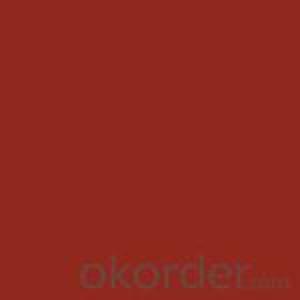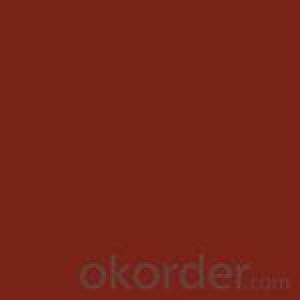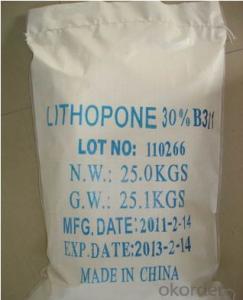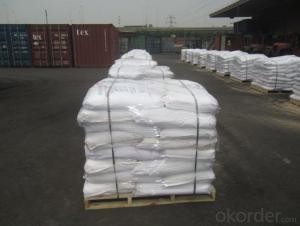Lithopone 28-30% LithoponeB301 B311 with factory direct sell price
- Loading Port:
- Tianjin
- Payment Terms:
- TT OR LC
- Min Order Qty:
- 20 m.t.
- Supply Capability:
- 2000 m.t./month
OKorder Service Pledge
OKorder Financial Service
You Might Also Like
Specifications of Lithopone
Lithopone ZnS-BaSO4
1. zinc: 28-30%,30%
2. Uses:paints,printing inks,coating,paper pigment,plastic
3. ISO,SGS
4. 25kg/bag
Lithopone ZnS-BaSO4 :
1. Commodity:
Lithopone (ZnS-BaSO4) for paint ink plastic paper etc
--------------------------------------------------------------------------------------------------------------
2. Description:
Lithopone B301 is a kind of lithopone whose hiding power is better than that of zinc oxide and worse than that of titanium dioxide.It has good heat-resisitance and is insoluble in water.
White powder, is a mixture of zinc sulfide and barium sulfate. Have high whiteness and good covering power. It is called Inorganic white pigment. Widely used as white pigment of plastics such as polyolefin, vinyl resin, ABS resin, polystyrene, polycarbonate, nylon and polyoxymethylene (POM), also for paint and ink . it is use to colourate for rubber products , linoleum, leather, paper, enamel.
-----------------------------------------------------------------------------------------------------------------
3. Features:
1) A white pigment produced by precipitation through filtering,
heating and quenching works
2) Has mostly been replaced by titanium dioxide which is more
durable, but it is much cheaper
---------------------------------------------------------------------------------------------------------------
4. Application:
Mainly used of coatings, printing ink, rubber, plastic, powder, profiles, paint, paper, and leather, etc.
1) Used as a base for lake pigment
2) Used as a inert pigment for paint, ink and cosmetics
3) A large range of applications in plastic industry
4) Used as a filler in paper, leather, and linoleum
---------------------------------------------------------------------------------------------------------------
5. Packaging:
Packing:25kgs per bag or according customer's requirements.
--------------------------------------------------------------------------------------------------------------
6. Specifications:
| ITEM | SPECIFICATIONS |
Zinc oxide,% | ≤0.60 |
Total zinc(on zinc sulfide basis),% | ≥28 |
Quality standard | GBT1707-95 |
Tinting strength(Relative) | ≥105 |
Total zinc sulfide and barium sulfate | ≥99.0 |
Water soluble % | ≤0.40 |
Oil absorption,g/100g, | ≤14.0 |
Sieve residue 45um % | ≤0.10 |
Volatile at 105°C g/100g | ≤0.30 |
Color | Not lower than standard sample |
| Hiding Power(contrast ratio) | Not lower than 5% of standard sample |

- Q: what is pigment dispersion syndrome?
- Pigment dispersion syndrome (PDS) is an affliction of the eye that, if left untreated, can lead a form of glaucoma known as pigmentary glaucoma. It takes place when pigment cells slough off from the back of the iris and float around in the aqueous humor. This is not what causes problems; however, if the pigment flakes clog the trabecular meshwork, preventing the liquids in the eye from draining, pressure can build up inside the eye. This pressure can cause permanent damage to the optic nerve. This condition is rare, but occurs most often in Caucasians, particularly men, and the age of onset is relatively low: mid 20s to 40s. Most sufferers are nearsighted. There is no cure as of yet, but PDS can be managed with eye drops or treated with simple surgeries. If caught early and treated, chances of glaucoma are greatly reduced. Sufferers are often advised not to engage in high-impact sports such as long-distance running or martial arts, as strong impacts can cause more pigment cells to slough off
- Q: Is gel food coloring a pigment or a dye?
- Dyes contain pigments, my friend. What is a pigment? They are like little beads. Very very tiny beads of the same color. Then if you spread these out, they give the thing a color. For example, the little green beads in leaves give it a green color. Pigment in our hair gives it a blonde/auburn/brown/black color. What is a dye? A dye is a liquid made up of water and pigments. The pigments are dissolved in water (well not really dissolve just that you cant see the beads) so that it's easier for us to use it. Everything that has a color is made up of pigments. So, gel food coloring is a thicker version of a dye that contains pigments.
- Q: what is the relationship between chlorophyll a, accessory pigment?
- Chlorophyll is the pigment that allows plants—including algae—to convert sunlight into organic compounds in the process of photosynthesis. Chlorophyll a is the predominant type found in algae and cyanobacteria (blue-green algae), and its abundance is a good indicator of the amount of algae present in the waters of the Chesapeake Bay. Excessive quantities of chlorophyll a can indicate the presence of algae blooms. These usually consist of a single species of algae, typically a species undesirable for fish and other predators to consume. Unconsumed algae sink to the bottom and decay, using up the oxygen required by other plants and benthic organisms to survive. The presence of too many nutrients, such as nitrogen and phosphorus, can stimulate algal blooms and result in reduced water clarity. Chlorophyll a also plays a direct role in reducing the amount of light avalable to plants in shallow-water habitats. This directly impacts the ability of underwater bay grasses to thrive. Like their terretrial cousins, grasses need sunlight to grow. As chlorophyll a levels increase, the amount of sunlight reaching underwater grasses declines. Chlorophyll a is the main pigment, chlorophyll b and carotenoids are accessory pigments. accessory pigments help broaden the absorbtion spectrum, as chlorophyll a absorbs violet-blue and red light. with the addition of accessory pigments chlorophyll b and carotenoids, yellow-green (chlor b) and violet and blue-green light (caro)
- Q: I have bought 2 Mac Pigment to use as eyeshadow,I thought it was supposed to be easy to use,turned out it wasn't.My eye looked like I got hit, so messy and the pigment was all over the place. I wonder if i should wet my brush or do u have some kind of tricks before applying it.Any advice would be appreciated.Thanks for helping.
- Just make it into a sort of paste. Like you said, wet the brush (this is what I do when using MAC pigment) by running it under the tap or dipping it into a container with a bit of water in. The reason I use a container is that you sometimes need to dampen the brush a couple of times and it saves you from getting up and finding a tap. This will stop it from getting everywhere and leaving a shimmer over your face! If I'm in a hurry, I find that blowing the applicator you're using to get rid of excess powder works just as well. Oh, and don't dab it in, make sure you properly brush it on, otherwise it tends to fall onto the tops of your cheeks.
- Q: What does it mean when something is highly pigmented?
- Pigment means color. So highly pigmented would mean lots of color.
- Q: Does anyone know its chemical formula or constituents ?
- Epona's answer is extremely sturdy. in case you seem up colour institutions you will locate diverse institutions reckoning on who has written them and what structures they're drawing from. yet you'll be able to desire to continually use institutions that make experience to you. case in point - you will in all probability locate that easy blue is the colour linked with peace. yet reckoning on what form of peace you're going for you may go with a diverse colour. possibly purple if that is for peace in the kin or with acquaintances, pink if that is religious in nature, or eco-friendly if that is physique appropriate. The institutions I genuinely tend to circulate with are: pink - lust, action, means, braveness Orange - creativity, braveness, means (extra innovative form than the pink). Yellow - issues bearing on the concepts (like possibly you have have been given a attempt to earnings for) or psychological suggestion. easy eco-friendly - prosperity darkish eco-friendly - therapeutic easy Blue - peace, tranquility darkish Blue - desires, on occasion suggestion pink - issues coping with the religious White - purification and can be a stand in for extremely just about something Black - liberating negativity, banishing purple - love, friendship, kin i do no longer think there is any colour that would desire to be prevented. yet I often use a diverse affiliation than what i've got listed. And my institutions are in user-friendly terms valid for yet somebody else in the event that they make experience to them. i exploit white candles maximum many times as I continually have them handy and that they might continually be spiced up with diverse oils this is something I do very often.
- Q: What are iridescent magnetic effect pigments?
- Iridescent okorder /... (really long explanation)
- Q: i bought the new neon pro pigments from mac , well 5 out of the six and i also bought 'basic red'i want to use these as eye shadows but i dont know howi also bought mac mixing medium for face and body but lol , i dont know how to use any of this stuffwhat can i do to use this stuff i mean will it turn out like regular eyeshadow if i use it right? will there be a shine to it? it will reduce fall out? should i put the mixing medium on my eye first , then let dry?do i need to possibly press the pigments in a pot with some kind of eye shadow liquid?i also bought the mascara mixing medium but want to know exactly what to do with thatand also , can i mix any of the pigments with lipgloss?http://cn1.kaboodle /hi/img/2/0/0/119/a/AAAAAlrx1LUAAAAAARmgiA.jpg
- look on youtube they have all the answers!
- Q: how to prepare coloured pigments?
- Pigment does not might desire to do with pores and skin inevitably, a paint could be tinted with a pigment. curiously it is likewise a dry colorant, many times an insoluble powder. pores and skin colour is set by using the quantity of melanin in one's pores and skin, relative to ranges of exposure to the sunlight.
- Q: I am 33 years old and have pigment dispersion syndrome. My new doctor prescribed laser treatment, to prevent eye damage and potential sight loss. A previous doctor said to try drops, but only if my eye pressure became high-risk. Has anyone in Yahoo's network been in my situation and if so, what did you do?
- Laser treatment for pigment dispersion is a fairly... I don't know what the word is. Modern? Progressive? It's something that isn't necessarily new, but it's definitely becoming more popular as an option, because it works fairly well without much risks. (Unlike medical treatment, where the drugs have much more common side effects.) Many people -- myself included -- have pigment dispersion syndrome, but not pigmentary glaucoma. The trick for us doctor types is to figure out which people are going to start having glaucoma and which ones won't. There's more to it than just pressure -- the amount of pigment, as well as the appearance/health of the optic nerve, any visual field damage, etc. There's also been some research suggesting that people with a particular shape of iris do better with laser treatment. If you're worried about it, make sure you're doing a visual field test regularly (I do mine yearly) and have your pressures monitored on a routine basis, and if anything shows up unusual, at least get a second opinion or consultation about the options.
Send your message to us
Lithopone 28-30% LithoponeB301 B311 with factory direct sell price
- Loading Port:
- Tianjin
- Payment Terms:
- TT OR LC
- Min Order Qty:
- 20 m.t.
- Supply Capability:
- 2000 m.t./month
OKorder Service Pledge
OKorder Financial Service
Similar products
Hot products
Hot Searches
Related keywords






























